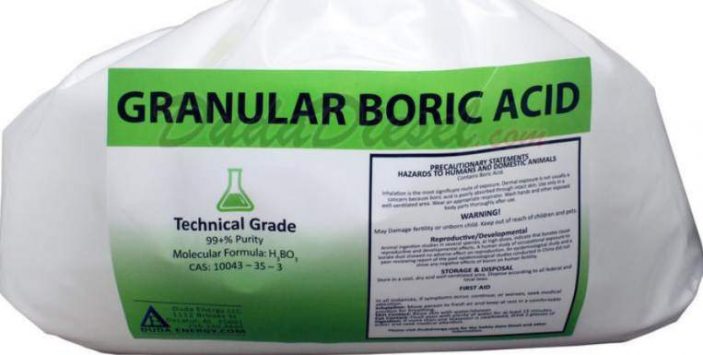Is the use of boric acid dangerous to cats, dogs, and other small pets? What causes the intoxication, what symptoms should I expect and how can the poisoning be treated and prevented?
Boric acid (orthoboric acid, acidum boricum, hydrogen borate or boracic acid) is a weak acid of boron used as a neutron absorber, pH buffer, as antiseptic, flame retardant, in monofilament fiberglass and as an insecticide, among other uses.
This water-soluble white powder or colorless crystals have various uses in cats including treating fleas (as an insecticide) together with its borax salt and as an eyewash solution (pharmaceutical grade).
Commercially, you may get it in tablet, pellet (crystal) or powder forms. It kills insects by abrading its outer skeleton.
We will be addressing whether this compound is toxic or safe to cats. We will separately cover boric acid for fleas in cats as well as its use as an eye wash for cats in separate posts.

Is boric acid harmful to cats and other pets?
Yes. If it is accidentally ingested in very huge amounts, boric acid toxic to cats, dogs, and other smaller pets, i.e., it is toxic to all living cells (cytotoxic). It can also cause skin and eye irritation.
However, it is not very toxic when compared to other household products for ants, flea, cockroach and other insects control such as insecticides.
Secondly, most of its symptoms will subside as it is excreted from the body leaving no serious long-term side effects unless in severe cases of poisoning.
Furthermore, as PetMD notes, “by following the rules and directions of EPA-approved boric acid powder products in your home, you, your family, and your pets should be safe.” This indicates that this product is safe for use if used as required by following its use instructions.
Finally, cat’s don’t typically lick this product. However, they can ingest it if it sticks on their paws as they try to clean them.
Note
By saying it is safe if used as required, we do not indicate that it is not hazardous. It is one of the household hazards for pets. Other hazards include antifreeze, fertilizers, rodenticides, insecticides, slug and snail baits as well as medications such as aspirin, paracetamol, ibuprofen, and some human NSAIDs (nonsteroidal anti-inflammatory drugs).
Besides being ingested, this acid is readily absorbed through the respiratory and gastrointestinal tract or damaged skin and this absorption is rapid if it is its pure state.
Finally, formulations intended to be used as bait as well as granular formulations tend to present a higher toxicity risk.
Toxicity symptoms
If ingested to its toxic levels, your pets will exhibit symptoms of its poisoning include vomiting, loss of appetite, depression and at times diarrhea.
However, if very huge amounts are ingested, symptoms such as “ seizures, renal tubular nephrosis, and, rarely, hepatotoxicity may be noted.”[1]
Also, in severe cases, especially in kittens, ill or older cats, you may notice difficulties in coordination, a depressed nervous system, and seizures.
On your pet’s skin, expect some irritation, redness, and swelling which will be worse if the affected area has wounds or cuts.
Treatment
In the case of boric acid intoxification, talk to your vet immediately. The use of activated charcoal is ineffective and forced vomiting may cause more harm. If it contacted the skin, wash it off to remove any remaining residue.
While treating this toxicity, your vet will conduct a gastrointestinal evaluations and provide supportive care. In severe cases, he or she may consider peritoneal dialysis and/or exchange transfusion to help bring down boron concentration in blood.
How to prevent poisoning
To reduce the chances of poisoning in cats:
- Read and follow all the instructions on the label.
- Store it safely in places where your pets or children cannot access
- Use gloves when handling granules or powder as well as surgical masks to avoid inhaling it.
- Apply it in crevices, cracks and remove any excess that may spill off.
